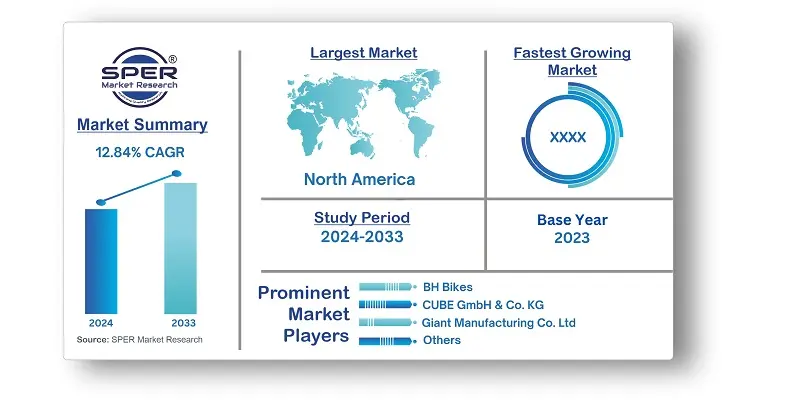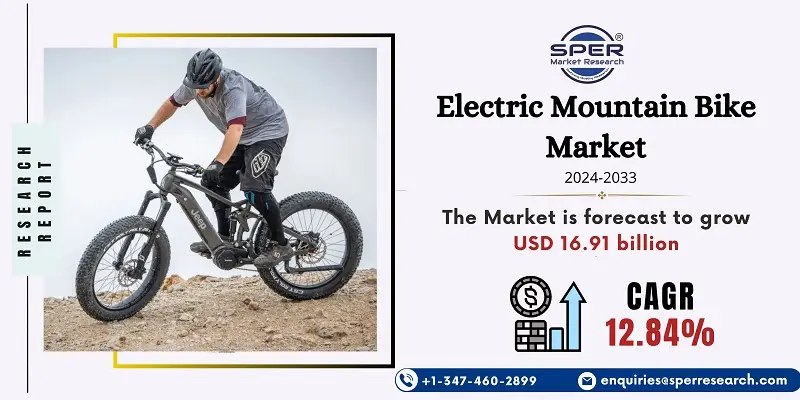
Electric Mountain Bike Market Trends, Growth, Size, Share, Demand, Revenue and Future Outlook
Electric Mountain Bike Market Size- By Propulsion Type, By Application- Regional Outlook, Competitive Strategies and Segment Forecast to 2033
| Published: Sep-2024 | Report ID: AMIN24197 | Pages: 1 - 248 | Formats*: |
| Category : Automotive & Transportation | |||
- Ducati introduced their new line of electric bikes in March 2022, which includes the Futa, an ultra-lightweight race e-bike. The motor, an FSA System HM 1.0 with 250W and 31 lb-ft of torque, is mounted on the back hub of the Futa, which has a carbon fiber monocoque frame with sports endurance geometry.
- December 2021: saw the introduction of the "F2i" and "F3i," India's first connected e-mountain bikes, by e-cycle manufacturer Hero Lectro. These electric-MTBs have a 250W BLDC motor with great torque and a large capacity 6.4Ah IP67 rated battery.


| Report Metric | Details |
| Market size available for years | 2020-2033 |
| Base year considered | 2023 |
| Forecast period | 2024-2033 |
| Segments covered | By Propulsion Type, By Application |
| Regions covered | North America, Asia-Pacific, Latin America, Middle East & Africa and Europe |
| Companies Covered | BH Bikes, CUBE GmbH & Co. KG, Giant Manufacturing Co. Ltd, Pedego Electric Bikes, Pivot Cycles, Scott Sports SA, Trek Bicycle Corporation, Trinx Bikes, Yamaha Motor Co. Ltd, Others. |
- Outdoor Enthusiasts
- Fitness Enthusiasts
- Commuters
- Cycling Professionals
- Tourists and Adventure Seekers
- Eco-conscious Consumers
- Recreational Riders
| By Propulsion Type: | |
| By Application: |
- Global Electric Mountain Bike Market Size (FY’2024-FY’2033)
- Overview of Global Electric Mountain Bike Market
- Segmentation of Global Electric Mountain Bike Market By Propulsion Type (Pedal-assisted, Throttle-Assisted)
- Segmentation of Global Electric Mountain Bike Market By Application (Leisure, Commuting)
- Statistical Snap of Global Electric Mountain Bike Market
- Expansion Analysis of Global Electric Mountain Bike Market
- Problems and Obstacles in Global Electric Mountain Bike Market
- Competitive Landscape in the Global Electric Mountain Bike Market
- Impact of COVID-19 and Demonetization on Global Electric Mountain Bike Market
- Details on Current Investment in Global Electric Mountain Bike Market
- Competitive Analysis of Global Electric Mountain Bike Market
- Prominent Players in the Global Electric Mountain Bike Market
- SWOT Analysis of Global Electric Mountain Bike Market
- Global Electric Mountain Bike Market Future Outlook and Projections (FY’2024-FY’2033)
- Recommendations from Analyst
1.1. Scope of the report1.2. Market segment analysis
2.1. Research data source2.1.1. Secondary Data2.1.2. Primary Data2.1.3. SPER’s internal database2.1.4. Premium insight from KOL’s2.2. Market size estimation2.2.1. Top-down and Bottom-up approach2.3. Data triangulation
4.1. Driver, Restraint, Opportunity and Challenges analysis4.1.1. Drivers4.1.2. Restraints4.1.3. Opportunities4.1.4. Challenges4.2. COVID-19 Impacts of the Global Electric Mountain Bike Market.
5.1. SWOT Analysis5.1.1. Strengths5.1.2. Weaknesses5.1.3. Opportunities5.1.4. Threats5.2. PESTEL Analysis5.2.1. Political Landscape5.2.2. Economic Landscape5.2.3. Social Landscape5.2.4. Technological Landscape5.2.5. Environmental Landscape5.2.6. Legal Landscape5.3. PORTER’s Five Forces5.3.1. Bargaining power of suppliers5.3.2. Bargaining power of buyers5.3.3. Threat of Substitute5.3.4. Threat of new entrant5.3.5. Competitive rivalry5.4. Heat Map Analysis
6.1. Global Electric Mountain Bike Market Manufacturing Base Distribution, Sales Area, Product Type6.2. Mergers & Acquisitions, Partnerships, Product Launch, and Collaboration in Global Electric Mountain Bike Market
7.1. Global Electric Mountain Bike Market Size, Share and Forecast, By Propulsion Type, 2020-20267.2. Global Electric Mountain Bike Market Size, Share and Forecast, By Propulsion Type, 2027-20337.3. Pedal-assisted7.4. Throttle-Assisted
8.1. Global Electric Mountain Bike Market Size, Share and Forecast, By Application, 2020-20268.2. Global Electric Mountain Bike Market Size, Share and Forecast, By Application, 2027-20338.3. Leisure8.4. Commuting
9.1. Global Electric Mountain Bike Market Size and Market Share
10.1. Global Electric Mountain Bike Market Size and Market Share By Region (2020-2026)10.2. Global Electric Mountain Bike Market Size and Market Share By Region (2027-2033)10.3. Asia-Pacific10.3.1. Australia10.3.2. China10.3.3. India10.3.4. Japan10.3.5. South Korea10.3.6. Rest of Asia-Pacific10.4. Europe10.4.1. France10.4.2. Germany10.4.3. Italy10.4.4. Spain10.4.5. United Kingdom10.4.6. Rest of Europe10.5. Middle East and Africa10.5.1. Kingdom of Saudi Arabia10.5.2. United Arab Emirates10.5.3. Qatar10.5.4. South Africa10.5.5. Egypt10.5.6. Morocco10.5.7. Nigeria10.5.8. Rest of Middle-East and Africa10.6. North America10.6.1. Canada10.6.2. Mexico10.6.3. United States10.7. Latin America10.7.1. Argentina10.7.2. Brazil10.7.3. Rest of Latin America
11.1. BH Bikes11.1.1. Company details11.1.2. Financial outlook11.1.3. Product summary11.1.4. Recent developments11.2. CUBE GmbH & Co. KG11.2.1. Company details11.2.2. Financial outlook11.2.3. Product summary11.2.4. Recent developments
11.3. Giant Manufacturing Co. Ltd
11.3.1. Company details11.3.2. Financial outlook11.3.3. Product summary11.3.4. Recent developments11.4. Pedego Electric Bikes11.4.1. Company details11.4.2. Financial outlook11.4.3. Product summary11.4.4. Recent developments11.5. Pivot Cycles11.5.1. Company details11.5.2. Financial outlook11.5.3. Product summary11.5.4. Recent developments11.6. Scott Sports SA11.6.1. Company details11.6.2. Financial outlook11.6.3. Product summary11.6.4. Recent developments11.7. Trek Bicycle Corporation11.7.1. Company details11.7.2. Financial outlook11.7.3. Product summary11.7.4. Recent developments11.8. Trinx Bikes11.8.1. Company details11.8.2. Financial outlook11.8.3. Product summary11.8.4. Recent developments11.9. Yamaha Motor Co. Ltd11.9.1. Company details11.9.2. Financial outlook11.9.3. Product summary11.9.4. Recent developments11.10. Others
SPER Market Research’s methodology uses great emphasis on primary research to ensure that the market intelligence insights are up to date, reliable and accurate. Primary interviews are done with players involved in each phase of a supply chain to analyze the market forecasting. The secondary research method is used to help you fully understand how the future markets and the spending patterns look likes.
The report is based on in-depth qualitative and quantitative analysis of the Product Market. The quantitative analysis involves the application of various projection and sampling techniques. The qualitative analysis involves primary interviews, surveys, and vendor briefings. The data gathered as a result of these processes are validated through experts opinion. Our research methodology entails an ideal mixture of primary and secondary initiatives.



Frequently Asked Questions About This Report
PLACE AN ORDER
Year End Discount
Sample Report
Pre-Purchase Inquiry
NEED CUSTOMIZATION?
Request CustomizationCALL OR EMAIL US
100% Secure Payment






Related Reports
Our Global Clients
Our data-driven insights have influenced the strategy of 200+ reputed companies across the globe.






















